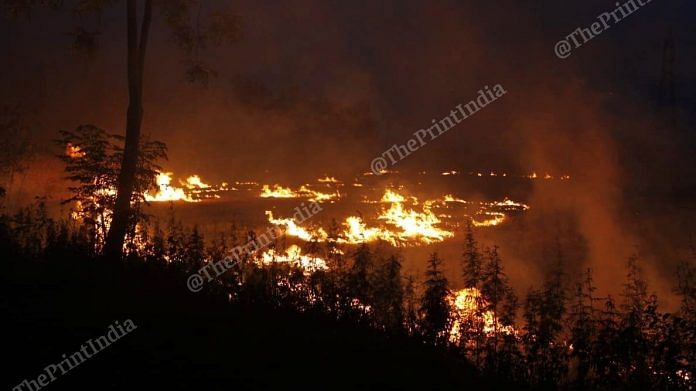New Delhi: Paddy stubble burning in Punjab and Haryana, which in recent years have been a major source of air pollution in Delhi-NCR, holds the potential to transform village economy, meet local energy demands and also provide alternative sources of income for farmers in northern India, says a study conducted by The Energy and Resources Institute (TERI).
Scientists at the New Delhi-based institute have proposed using paddy straw as fuel for running decentralised cold storage units at the village level.
The report says there is a huge demand for solid fuel — such as coal and wood — to run cold storage units and brick kilns in the two states. It also says that creating a biomass supply chain involving entrepreneurs and setting up facilities to convert crop residue into fuel pellets can help farmers find value in waste. This, in turn, will aid in curbing air pollution.
Around 35 million tonnes of biomass crop are burned each year in Punjab and Haryana alone — a phenomena that has been blamed for the rising levels of air pollution plaguing the capital city every winter.
Ban on stubble burning
While the Punjab Pollution Control Board has put a ban on burning of crop residue, lack of alternatives to dispose of this waste has led many farmers to openly flout the law.
Mechanised harvesters do not remove crop from under the ground, leaving behind stubble. According to Sunil Dhingra, senior fellow at TERI, farmers have to employ additional labour, diesel and give more time in removing these stalks from fields.
For the farmers then lighting a matchstick is ‘simple and effective’.
“Unless there is an additional value for the stubble, farmers are not going to be interested in removing it. So more and more of them are resorting to burning stubble. Satellite data shows how stubble burning has also been taking place in states such as Madhya Pradesh and Chhattisgarh,” Dhingra said.
Also read: Only innovative solutions that don’t burden farmers can end stubble burning
Demand for cooling units
In their study, the researchers found that there is a huge energy requirement to run cooling units in most districts of Punjab and Haryana, where there is surplus milk production.
“This surplus is collected in bulk milk chillers — having capacities of 15,000 to 20,000 litres — run by clusters of villages. From here, the milk is collected and taken to processing units.
This huge requirement of cooling energy is conventionally met through grid electricity,” he said.
The researchers also looked at the possibility of encouraging farmers to grow crops other than rice, especially horticulture farming.
“But one of the main problems with horticulture farming is that the produce has to be sold immediately in local markets. Unless villages have decentralised cold storage chains, farmers will not show interest in horticulture crops,” Dhingra said. “Again, such a facility requires cooling energy.”
He pointed out that fuel is also needed for brick kilns and local dhabas.
The Ministry of Agriculture and Farmers’ Welfare has taken the initiative to address stubble burning through in-situ management practices such as use of ‘Happy Seeders’ — a tractor-mounted device that can cut and lift previous crop and sow new ones in its place — and other farm machinery.
But the TERI report shows how Happy Seeders is a “very heavy machinery and requires higher capacity tractors”.
“Farmers do not always own such tractors. Our survey has shown how adoption of Happy Seeders has hence remained limited,” Dhingra added.
Instead, the study suggests that the government should invest in creating a business model or provide policy incentives to encourage farmer groups to create a mechanism for collection of crop residue.
More machinery required
There is, however, another challenge in collecting and transferring stubble. Large amounts of stubble is pulled out at one go and farmers have to clear fields within a short window of two to three weeks. For this, a whole lot of machinery will be required throughout the state at the same time.
The report also states that more analysis is needed to assess which methods of collecting residue from the field can be viable to improve the socio-economic conditions of farmers while also minimising negative impact on the environment.
It recommends setting up of an independent platform to facilitate collaboration between industries and academia — which will help develop a process for identification of innovative techno-economic cooling options suitable for Indian conditions.
The platform will also help identify advanced energy efficient cooling technologies.
Also read: Few takers for Punjab govt’s ‘best’ solution to stubble burning



